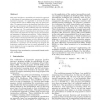75 search results - page 8 / 15 » Termination Analysis of Higher-Order Functional Programs |
EUROGP
2005
Springer
14 years 1 months ago
2005
Springer
We describe an approach to understanding evolved programs for a real world object detection problem, that of finding orthodontic landmarks in cranio-facial X-Rays. The approach in...
ICFP
2002
ACM
14 years 7 months ago
2002
ACM
Compilers for dynamically and statically typed languages ensure safe execution by verifying that all operations are performed on appropriate values. An operation as simple as car ...
IPL
2007
13 years 7 months ago
2007
We present a characterization of first-order functional programs which are quasiterminating w.r.t. the symbolic execution mechanism of needed narrowing, i.e., computations in the...
ACSC
2004
IEEE
13 years 11 months ago
2004
IEEE
This paper introduces a repeatable and constructive approach to the analysis of loop progress and termination conditions in imperative programs. It is applicable to all loops for ...
TOPLAS
2008
13 years 7 months ago
2008
lem of inferring termination from such abstract information is not the halting problem for programs and may well be decidable. If this is the case, the decision algorithm forms a &...

